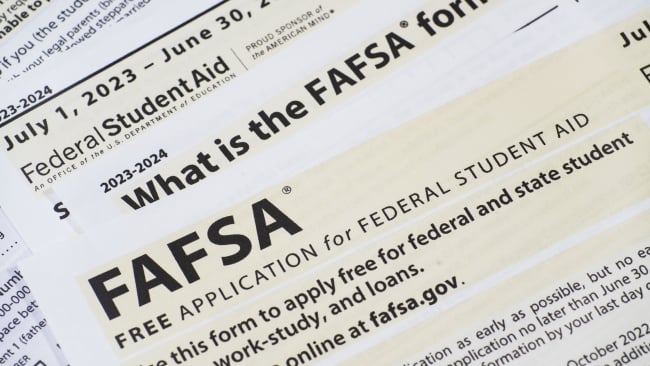You have /5 articles left.
Sign up for a free account or log in.

Richard Stephen/iStock/Getty Images Plus
Congressional leaders of both parties have expressed outrage over the failure of the Biden administration’s Department of Education to publish and process the new, simplified Free Application for Federal Student Aid (FAFSA) on time and error free. They are responding appropriately to the thousands of institutions and millions of students who rely on the federal student aid system to function with minimal problems.
But the focus on a technically challenging implementation process has distracted from another more serious issue: the patently unfair methodology Congress has designed for using FAFSA data to distribute aid. It will soon become clear that this “Better FAFSA” formula penalizes parents who work hard, provide a stable home for their children and meet their tax obligations.
The Education Department has estimated that more than 1.5 million additional students will be eligible for the maximum Pell Grant under the new formula, largely because of more generous income-protection allowances set by Congress. Less trumpeted is the fact that the new methodology will inflict harm by lowering aid to many families—including low-income families—if a child’s parents get and stay married, get remarried or are honest about their co-living situation. It’s one thing when frustrated constituents are waiting for that much-anticipated financial aid award letter. It will be quite another when families learn that their child has lost aid eligibility so that other students—including those whose parents have gamed the system or are dishonest about their living arrangements—will receive more aid.
Under the former methodology, the Education Department used a family’s income and asset data from their FAFSA to calculate an estimated family contribution (EFC), or the amount that the government determined families had to contribute toward college costs, even if the family had to borrow from the federal government to do so. The new methodology replaces the EFC with a different indicator called the student aid index (SAI). While the SAI still determines how much a family must contribute to college costs, it also makes more visible and significantly expands the penalties for married parents.
Marriage penalties are not new to the federal student aid program. Under both the EFC and the SAI calculations, only married parents must both report their full income and assets on the FAFSA. If a student’s parents are unmarried, the second parent does not need to complete the FAFSA, providing a significant disincentive for marriage and substantial income protection for unmarried parents. In theory, unmarried parents who live together are both supposed to report their incomes and assets, but the government and colleges would be hard-pressed to enforce this provision as it is difficult to prove permanent cohabitation.
Under the SAI, there are also serious penalties in store for those who marry again. While biological parents are absolved of responsibility to help pay college costs of their child if they never married or if they divorced the child’s other parent, they are responsible for the college costs of a new spouse’s child. As marriage rates continue to decline in America, Congress might rethink this approach.
The SAI also seems to create other new marriage penalties. For example, the new SAI treats child-support payments received as an asset rather than earnings. The SAI expects that a much higher portion of earnings will be used to pay college costs (as much as 47 percent) than the portion of assets (about 12 percent). So, the unmarried parent who receives child-support payments receives a much larger income-protection allowance. Of course, this not only affects married parents with earnings but also single parents. For example, a single mother who works to support her family is expected to pay more college expenses than a single mother whose ex-spouse makes sizeable child-support payments. It is both a penalty on marriage and a penalty on work.
Another marriage penalty comes in the form of AGI (adjusted gross income) caps for automatically receiving full Pell grants. A student with an unmarried parent will automatically receive a full Pell Grant (roughly $7,400) if the parent’s AGI is less than or equal to 225 percent of the poverty guideline for their state. In contrast, if the student’s parents are married, the income cap for a full Pell Grant is lower—175 percent of the poverty guideline. Again, students of married, working parents are penalized.
Students with married parents who earn more than 175 percent of the poverty guideline face a second penalty. Not only will they not automatically qualify for a full Pell Grant, but they will be expected to contribute an even larger portion of their earnings to college costs. That’s because even if both parents work, only one parent will qualify for an employment expense offset (the part of one’s income that is reserved for work-related expenses like transportation). Yet when two parents work, employment-related expenses are higher than when one parent works. In technical terms, we refer to this as the double whammy.
The SAI methodology imposes other troubling penalties on middle- and lower-income, two-earner families. For example, while the former EFC divided a family’s expected contribution by the number of children in college, the SAI methodology takes the opposite approach. It applies the same SAI to each child in college, as if doubling the number of children a family has enrolled in college automatically doubles that family’s income in a given year.
Finally, there is confusion about when a parent’s or student’s failure to file tax returns makes them automatically eligible for a full Pell Grant. While the previous EFC methodology triggered an automatic “zero contribution” for parents not required to file taxes, the Department of Education’s 2024–25 FAFSA Pell Eligibility and Student Aid Index Guide does not distinguish between parents who are not required to file taxes and those who simply choose to commit tax evasion. That said, the Department’s 2024–25 Federal Student Aid Handbook appears to restore that distinction, and we hope that’s the case.
To actually realize the potential of a “better” FAFSA formula, Congress should take a number of steps.
- At a minimum, Congress should recognize that a family’s income and assets are spread among multiple students when they are enrolled in postsecondary education. The EFC had this right, and it should be restored.
- In addition, income from child support should be treated the same as income from earnings when determining a parent’s ability to provide college tuition assistance. After all, child-support payments are supposed to be used to care for the child.
- Since child-support payments recognize that both parents have a financial responsibility to their child, the income and assets of both parents should be considered in determining a student’s eligibility for aid. Many institutions that use the College Board’s financial aid methodology already require both parents to report assets and income, which is why many students who qualify for Pell Grants do not qualify for institutional aid.
- Finally, the earnings cap for full Pell Grant eligibility should be the same for all students’ families, regardless of living arrangements or marital status, and each earner whose wages are included in the SAI calculation should be afforded an income-protection allowance for work-related expenses.
FAFSA simplification and this year’s FAFSA fiasco have undermined the longtime desire of Congress and the financial aid community to simplify the FAFSA and make it fair. Congress should now take swift action to restore fairness and fiscal responsibility to the federal student aid program.








